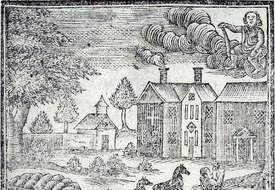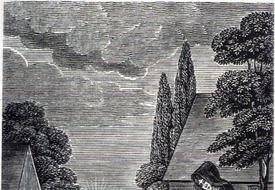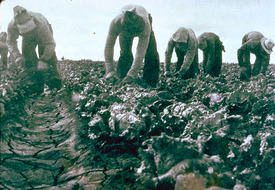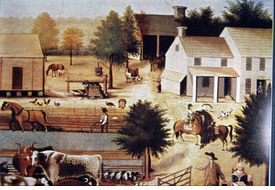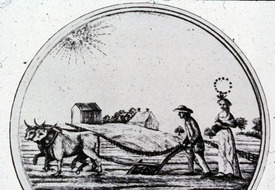'Hercules and the Waggoner' 1747
Image ID: 8708
Collection: Karen Halttunen
Topic(s): Nineteenth Century, Agrarianism, Agriculture
Region(s): United States
CA Standard(s): 8.4 - The aspirations and ideals of the people of the new nation
National Standard(s): Revolution and the New Nation (1754-1820s)
Card Text: Benjamin Franklin, "Hercules and the Waggoner," 1747; depicts Pennsylvania grain prosperity
Citation: The John Carter Brown Library, Brown University, Providence, RI 02912
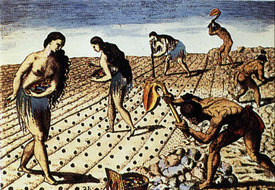
Timucuan Women, FL, 1560s
Image ID: 6839
Collection: Karen Halttunen
Topic(s): Seventeenth Century, Native Americans, Agriculture, Discovery and Conquest, Indian Civilization, Indian-White Relations Before Revolution
Region(s): United States, North America
CA Standard(s): 5.1 - The major pre-Columbian settlements…, 5.2 - Routes of early explorers and early explorations of the Americas, 5.3 - The cooperation and conflict among the American Indians and between the Indian nations and the new settlers
National Standard(s): Three Worlds Meet (Beginnings to 1620) , Colonization and Settlement (1585-1763), Revolution and the New Nation (1754-1820s) , Intensified Hemispheric Interactions 1000-1500 CE, The Emergence of the First Global Age, 1450-1770
Card Text: Jacques LeMoyne, "Timucuan Women," Florida, 1560s, working in agriculture with men. Men plowed and women planted beans and maize. "They be all naked and of goodly stature, mighty, faire and as well shapen…as any people in all the worlde, very gentill, curtious and of good nature… the men be of tawny color, hawke nosed and of a pleasant countenance…the women be well favored and modest…" French explorer Jean Ribault was impressed by these first Native peoples he encountered in Florida. The Timucuans under Chief Saturiwa, who met the French at the mouth of the River of May (later called the St. Johns River) in 1562, were one of a number of Timucua-speaking tribes who inhabited central and northern Florida and southeastern Georgia. Their way of life had remained essentially unchanged for more than 1000 years. Attacks, slavery and disease reduced their numbers. During the Spanish mission period (1595 - 1700) the Timucua population collapsed, from 50,000 people to 1,000, a loss of 98 percent. When the British took over Florida from the Spaniards in 1763, only one Timucua was reported to have survived.
Citation: Library of Congress Rare Book and Special Collections Division, Washington, DC 20540. LC-USZC4-4821. Text: "Timucua," Timucuan Ecological & Historic Preserve Florida, National Park Service, 12713 Fort Caroline Rd, Jacksonville, FL 32225. https://www.nps.gov/timu/learn/historyculture/ timucua.htm. Nov 28, 2017.
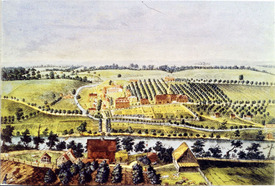
Garrison, Bethlehem, Pennsylvania, 1757
Image ID: 12886
Collection: Alan Taylor
Topic(s): Colonies, Agriculture
Region(s): North America, United States
CA Standard(s): 5.4 - Political, religious, social, and economic institutions that evolved in the colonial era. , 5.4 - Political, religious, social, and economic institutions that evolved in the colonial era. , 8.1 - Major events preceding the founding of the nation and the development of American constitutional democracy
National Standard(s): Revolution and the New Nation (1754-1820s)
Card Text: Nicholas Garrison, "Bethlehem," PA, 1757, a Moravian community: "A view of Bethlehem, one of the Brethren's principal settlements, in Pennsylvania, North America." J. Noual hand-colored engraving.
Citation: New York Public Library, Miriam and Ira D. Wallach Division of Art, Prints and Photographs, Fifth Ave & 42nd St, New York, NY 10018. Digital Image ID: 53929. Also, Palmer Museum of Art, partial gift and purchase from John C. O'Connor and Ralph M. Yeager. Acc. No. 86.396.
'Wethersfield Girls Weeding Onions' 1780
Image ID: 8973
Collection: Karen Halttunen
Topic(s): Nineteenth Century, Pre-Industrial Work - Misc., Agriculture
Region(s):
CA Standard(s): 8.4 - The aspirations and ideals of the people of the new nation
National Standard(s):
Card Text: "Wethersfield Girls Weeding Onions," Wethersfield, CT, 1780
Citation: Courtesy of The Wethersfield Historical Society, Town Hall, 505 Silas Deane Hwy, Wethersfield, CT 06109. All rights reserved. Our thanks to the Society.
Filipinos working in lettuce field, Salinas, California, 1935
Image ID: 5716
Collection: Roland Marchand
Topic(s): The Great Depression, Sharecroppers and rural US, Agriculture
Region(s): United States
CA Standard(s): 11.6 - The Great Depression and how the New Deal changed the role of the federal government
National Standard(s): The Great Depression and World War II (1929-1945)
Card Text: "Filipinos working in lettuce field, Salinas, California," 1935.
Citation: Dorothea Lange photo. Library of Congress, Prints & Photographs Division, FSA/OWI Collection, Washington, DC 20540. LC-USF347- 000826-D. In Forrest Jack Hurley, Portrait of a Decade, 1972, p. 53.
11.6.5
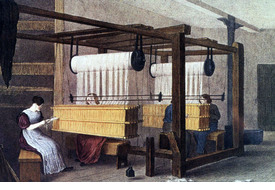
Female and Child Factory Workers Reeding or Drawing in at Loom, England, 1840
Image ID: 8331
Collection: Karen Halttunen
Topic(s): Nineteenth Century, Lowell, Agriculture, Arts and Architecture, British Empire, Business 19th century, Child labor, Class Structure, Cooption of styles, Corporate Image, Early mills and factories, Early National Period, Emerging industrial city, Environmental History, Factory as symbol, Gender-Bending, Imperialism, Industrial Revolution, Institutions and social disorder, Invention, Labor, Labor Organizations and Leaders, Market Economy, National Events, Nineteenth Century Children, Nineteenth Century Furniture, Nineteenth Century Interiors, Strikes and Violence, Success 19th century, Sweatshops, Technology, Urbanization, Victorian Culture, Women and Health, Women in labor movement, Women's organizations, Women's work, Work and Housing, Work and Workers
Region(s): United States, Europe
CA Standard(s): 8.6 - The divergent paths of the American people from 1800 to the mid-1800s...with emphasis on the Northeast. , 5.8 - The colonization, immigration, and settlement patterns of the American people from 1789 to the mid-1800s..., 7.10 - The historical developments of the Scientific Revolution and its lasting effect on religious, political, and cultural institutions, 10.3 - The effects of the Industrial Revolution in England, France, Germany, Japan, and the United States. , 10.4 - Global change in the era of New Imperialism in Africa, Southeast Asia, China, India, Latin America, and the Philippines
National Standard(s): Expansion and Reform (1801-1861)
Card Text: Female and child factory workers reeding or drawing in at large cotton loom, England, 1840. Thread reeding is the process of arranging fabric threads on a loom in the correct order before weaving begins. Reeding allows the same loom to make both very fine and very coarse fabric, and to weave threads at very different densities.
"The Beam full of yarn, after being dressed with size to stiffen and strengthen the threads, is brought to the Drawing-in Frame, and hung up as you see in the picture, the Healds which are made of twisted worsted, or Cotton, are hung under the beam and weighted below. The ends of the warp are then drawn down, and the rods hung up to preserve the lease, or the warp could not be woven. There is a female at each side of the healds; one takes hold of the ends of the warp, and gives them separately to the other, who draws them through the healds. When all the ends are through, the Drawing-in is completed. Next comes the Reeding; a reed consists of a great number of short flat pieces of steel or brass called Dents, fixed at short and equal distances from each other, in long pieces of split cane, and tightly secured with a wax band. Through each space, between the dents, two ends are drawn by a small hook, called a Reed-hook. It is not always necessary to draw the warps in; they can also be twisted in, that is, when the warp is nearly all woven into cloth by the weaver, the yarn is cut off, and the fresh warp twisted to the old one. Drawing-in and Reeding is very tedious work and requires great care, there are not only a great number of threads to draw in and reed, but if they were to miss one dent or one heald, it is probable that the whole or a part of the work would have to be done over again. Since this is the case, the steady, careful look of the girls is not to be wondered at."
"Factory Rules from the Handbook to Lowell, 1848: REGULATIONS TO BE OBSERVED by all persons employed in the factories of the Hamilton Manufacturing Company. The overseers are to be always in their rooms at the starting of the mill, and not absent unnecessarily during working hours. They are to see that all those employed in their rooms, are in their places in due season, and keep a correct account of their time and work. They may grant leave of absence to those employed under them, when they have spare hands to supply their places, and not otherwise, except in cases of absolute necessity. All persons in the employ of the Hamilton Manufacturing Company, are to observe the regulations of the room where they are employed. They are not to be absent from their work without the consent of the over-seer, except in cases of sickness, and then they are to send him word of the cause of their absence. They are to board in one of the houses of the company and give information at the counting room, where they board, when they begin, or, whenever they change their boarding place; and are to observe the regulations of their boarding-house. Those intending to leave the employment of the company are to give at least two weeks' notice thereof to their overseer. All persons entering into the employment of the company, are considered as engaged for twelve months, and those who leave sooner, or do not comply with all these regulations, will not be entitled to a regular discharge. The company will not employ anyone who is habitually absent from public worship on the Sabbath, or known to be guilty of immorality. A physician will attend once in every month at the counting-room, to vaccinate all who may need it, free of expense. Anyone who shall take from the mills or the yard, any yarn, cloth or other article belonging to the company, will be considered guilty of stealing and be liable to prosecution. Payment will be made monthly, including board and wages. The accounts will be made up to the last Saturday but one in every month, and paid in the course of the following week. These regulations are considered part of the contract, with which all persons entering into the employment of the Hamilton Manufacturing Company, engage to comply. JOHN AVERY, Agent."
"… Miss Sarah G. Bagl[e]y said she had worked in the Lowell Mills eight years and a half, six years and a half on the Hamilton Corporation, and two years on the Middlesex. She is a weaver, and works by the piece. She worked in the mills three years before her health began to fail. She is a native of New Hampshire, and went home six weeks during the summer. Last year she was out of the mill a third of the time. She thinks the health of the operatives is not so good as the health of females who do housework or millinery business. The chief evil, so far as health is concerned, is the shortness of time allowed for meals. The next evil is the length of time employed - not giving them time to cultivate their minds. She spoke of the high moral and intellectual character of the girls. That many were engaged as teachers in the Sunday schools. That many attended the lectures of the Lowell Institute; and she thought, if more time was allowed, that more lectures would be given and more girls attend. She thought that the girls generally were favorable to the ten hour system. She had presented a petition...to 132 girls, most of whom said that they would prefer to work but ten hours. In a pecuniary point of view, it would be better, as their health would be improved. They would have more time for sewing. Their intellectual, moral and religious habits would also be benefited by the change."
Citation: J.R. Barfoot, "The Progress of Cotton, 1835-40," #9: "Reeding or Drawing in," in a series of 12 prints. Slater Mill Historic Site, 67 Roosevelt Ave, Pawtucket, RI 02860. First text: Public domain: "The Progress of Cotton No. 9: Reading or Drawing In," 1840. From Barfoot's series of colored lithographs of 1840 depicting the cotton manufacturing process. Original text written to accompany Lithograph No.9. https://www.flickr.com/photos/ manchesterarchiveplus/6503188589/in/album-72157629084961692/. Manchester Archives, Manchester Central Library, Manchester City Council, Town Hall, Albert Square, Manchester M60 2LA, UNITED KINGDOM. Second text: Public domain: "Factory Rules from the Handbook to Lowell, 1848." https: //chnm.gmu.edu/mcpstah/wordpress/wp-content/themes/tah/files/mckee_primary-sources.pdf. Roy Rosenzweig Center for History and New Media, Department of History and Art History, George Mason University, 4400 University Dr, MSN 1E7, Fairfax, VA 22030. Third text: Public domain.
"Report," Massachusetts House Document, no. 50, March, 1845. https://archives.lib.state.ma.us/bitstream/handle/2452/755732/ocm39986872-1845-HB-0050.pdf?sequence=1&isAllowed=y. State Library of Massachusetts, 24 Beacon St, State House Rm 341, Boston, MA 02133. Sept 7, 2023.
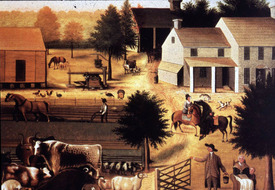
The Residence of David Twining 1845-7
Image ID: 8713
Collection: Karen Halttunen
Topic(s): Nineteenth Century, Agrarianism, Agriculture
Region(s): United States
CA Standard(s): 8.12 - The transformation of the American economy and the changing social and political conditions…in response to the Industrial Revolution, 8.6 - The divergent paths of the American people from 1800 to the mid-1800s...with emphasis on the Northeast. , 8.1 - Major events preceding the founding of the nation and the development of American constitutional democracy
National Standard(s): Expansion and Reform (1801-1861)
Card Text: Edward Hicks, "The Residence of David Twining," Bucks County, PA, 1845-7; the artist is the boy at lower right, the Twinings his foster family; oil on canvas, 26 1/2 x 31 9/16 in. unframed
Citation: Courtesy of The Abby Aldrich Rockefeller Folk Art Museum, The Colonial Williamsburg Foundation, P.O. Box 1776, Williamsburg, VA 23187-1776. From the collection of Abby Aldrich Rockefeller; gift of David Rockefeller. 1933.101.1. All rights reserved. Our thanks to The Museum.
The Residence of David Twining, 1787
Image ID: 11442
Collection: Louis Warren
Topic(s): Agriculture
Region(s): United States
CA Standard(s): 8.4 - The aspirations and ideals of the people of the new nation
National Standard(s): Revolution and the New Nation (1754-1820s)
Card Text: Towards_Revolution34
"The Residence of David Twining, 1787," a farm in Bucks County, PA. Edward Hicks, oil, 1845-48. The artist is the boy at lower right, the Twinings his foster family.
Citation: Courtesy of The Abby Aldrich Rockefeller Folk Art Museum, Colonial Williamsburg Foundation, PO Box 1776, Williamsburg, VA 23187-1776. All rights reserved. Our thanks to Colonial Williamsburg.
'Venerate the Plough' 1786
Image ID: 8714
Collection: Karen Halttunen
Topic(s): Nineteenth Century, Agrarianism, Agriculture
Region(s): United States
CA Standard(s): 8.1 - Major events preceding the founding of the nation and the development of American constitutional democracy, 8.4 - The aspirations and ideals of the people of the new nation
National Standard(s): Revolution and the New Nation (1754-1820s)
Card Text: "Venerate the Plough," 1786, etching
Citation: Columbian Magazine, 1786. Library of Congress Rare Book and Special Collections Division, Washington, DC 20540. LC-USZ62-31153
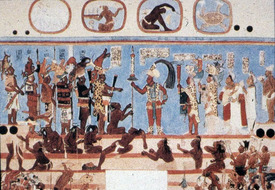
Maya Society Mural, Bonampak, Chiapas, Mexico, c. 800 AD/CE
Image ID: 6688
Collection: Karen Halttunen
Topic(s): Ancient Mexico, Agriculture, Indian Civilization, Indian Portraits, Meso-American, Native Americans
Region(s): Latin America, North America, Mexico
CA Standard(s): 7.7 - The geographic, political, economic, religious, and social structures of the Meso-American and Andean civilizations, 5.1 - The major pre-Columbian settlements…
National Standard(s): The Emergence of the First Global Age, 1450-1770, Intensified Hemispheric Interactions 1000-1500 CE
Card Text: Maya wall mural suggesting an elaborate class system of a complex agricultural society, Bonampak, Chiapas, Mexico, c. 800 AD/CE. A rarely-preserved expression of Maya artistry – painting – comes to life at the archaeological site of Bonampak, in southern Chiapas, Mexico. The small site of three temple rooms houses one of the most famous painted murals in the entire Maya world. Bonampak literally means "painted wall." Vivid colors and masterful designs tell the story of the last ruling family of Bonampak, headed by King Chan Muwan and his wife Lady Rabbit. Calendar inscriptions date the painted scenes between the years 790 and 792 CE. The city was abandoned shortly after, and the murals were never completed. The paintings depict scenes of kingly accession and celebration, brutal warfare, and acts of self-sacrifice. Here members of King Ahau Chan Muwan's court display their power over their defeated rivals in a brutal battle scene.
Painted around 800 AD/CE, these three rooms of paintings reveal in astonishing detail the ancient Maya at the end of their splendor, engaging in court rituals and human sacrifice, wearing elegant costumes and stripping the clothing from fallen captives, acknowledging foreign nobles and receiving abundant tribute. No other surviving work features so many Maya engaged in the life of the court, whether second-tier warriors presenting captives to the king or the king’s mother pushed to the side by her imperious daughter-in-law. Costumes, musical instruments, and the weapons of war are all rendered with great detail, making Bonampak an unparalleled resource for understanding ancient society. The ancient Maya began to build vast cities in northern Guatemala during the first millennium BCE, mastering a harsh tropical environment with shallow soils and annual cycles of deluge and drought. These first cities were the foundation of the greatest civilization of the ancient New World. By 700 AD/CE their towering pyramids and dramatic public monuments dominated dozens of Maya cities across what is now Honduras, Belize, southern Mexico and Guatemala. From at least the 5th century onward, lords at Bonampak skirmished with those from Yaxchilan, 26 kilometers away; but by the 8th century the royal families at the two cities had achieved peace. The king who commissioned the paintings at Bonampak, Chaan Muwan, married a Yaxchilan princess. By 800, when the paintings were nearly completed, the region was suffering from deforestation, exhausted farmland, and overpopulation. Some cities were burned to the ground; others were simply abandoned. By 900 the forest had begun to reclaim the area. Years later Spanish invaders found the region of Bonampak sparsely inhabited, although great Maya populations survived in Yucatan and Guatemala.
Citation: Photo and first text: Copyright © National Museum of the American Indian, Smithsonian Institution, PO Box 37012, SI Building, Rm 153, MRC 010, Washington, DC 20013-7012. https://maya.nmai.si.edu/gallery/bonampak. All rights reserved. Second text: "The Maya Murals of Bonampak: Windows on an Ancient Culture." Copyright © 2017, Yale Peabody Museum of Natural History, 170 Whitney Ave, New Haven, CT 06511. http://peabody.yale.edu/ exhibits/maya-murals-bonampak. All rights reserved. Oct 1, 2017.
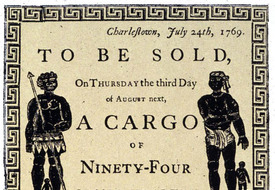
Slave Auction Notice, 1769
Image ID: 6978
Collection: Karen Halttunen
Topic(s): Early American Slavery, Slavery and Abolition, 18th Century Families, 18th Century Portraits, Abolition, Agriculture, Business, Charleston, Colonial America, Columbian Exchange, Developing Nations, Early Ads, Early National Period, Immigrant Societies and Organization, Labor, Market Economy, Nineteenth Century Slavery, Slave Trading, Slavery, Working, and Living Conditions
Region(s): United States, Caribbean, North America
CA Standard(s): 8.7 - The divergent paths of the American people in the South from 1800 to the mid-1800s , 5.4 - Political, religious, social, and economic institutions that evolved in the colonial era. , 5.7 - People and events associated with the development of the U.S. Constitution and it's significance as the foundation of the American republic, 5.8 - The colonization, immigration, and settlement patterns of the American people from 1789 to the mid-1800s..., 7.10 - The historical developments of the Scientific Revolution and its lasting effect on religious, political, and cultural institutions, 7.11 - political and economic change in the sixteenth, seventeenth, and eighteenth centuries (the Age of Exploration, the Enlightenment, and the Age of Reason), 8.1 - Major events preceding the founding of the nation and the development of American constitutional democracy, 8.10 - The multiple causes, key events, and complex consequences of the Civil War
National Standard(s): Colonization and Settlement (1585-1763), Revolution and the New Nation (1754-1820s) , The Emergence of the First Global Age, 1450-1770, An Age of Revolutions, 1750-1914
Card Text: Slave auction notice, Charleston, SC, wharf, 1769. "Charleston, July 24, 1769, To Be Sold. on Thursday, the third Day of August next, a CARGO of ninety-four Prime Healthy Negroes, consisting of thirty-nine Men, fifteen Boys, twenty-four Women, and sixteen Girls. Just arrived, in the Brigantine Dembia, Francis Bare, Master, from Sierra Leone, by David and John Deas." Slave auctioneering was a lucrative business in the colonies. Auctioneers of enslaved Africans were considered regular members of society, their auctions held in public and attended by large crowds. During the colonial period two styles of auction developed. In “grab and go” auctions, purchasers and the auctioneer negotiated a single price for all the slaves. They then met in large pens where the enslaved people were held; the auctioneer threw open the gates, and the purchasers raced in to grab the slaves they wanted. Then they paid the auctioneer the agreed-upon price to leave the pen with the slave. Here is a description of such a sale:
“...I was witness to a sale by scramble, where about 250 Negroes were sold. All the Negroes bear an equal price; which is agreed upon between the captains and the purchasers before the sale begins. On a day appointed, the Negroes were landed and placed together in a large yard belonging to the merchants to whom the ship was consigned. As soon as the hour agreed on arrived, the doors of the yard were suddenly thrown open and in rushed a considerable number of purchasers, with all the ferocity of brutes. Some instantly seized such of the Negroes as they could conveniently lay hold of with their hands. Others being prepared with several handkerchiefs tied together, encircled as many as they were able. While others, by means of a rope, effected the same purpose. It is scarcely possible to describe the confusion....”
In the “Highest Bidder” method, slaves were brought up individually and prospective purchasers were allowed to “inspect” the slave. Enslaved persons were made to walk or jump on stage. Purchasers would inspect teeth and look for hidden injuries. These inspections could even include strip searches. The auctioneer then called out a price that was accepted by willing buyers. The auctioneer continued to call out higher amounts until no one would bid; at that point the purchaser with the highest bid “won” the rights to the enslaved person. Normally, young adult men were the most valuable due to the type of work they were able to do and a typically long life-span. Values would decrease based on factors such as age, gender, perceived health and docility (or likelihood to rebel). A slave described his experience at an auction:
“The gentleman...would make us hold up our heads, walk briskly back and forth, while customers would feel of our hands and arms and bodies, turn us about, ask us what we could do, make us open our mouths and show our teeth, precisely as a jockey examines a horse which he is about to barter for or purchase. Sometimes a man or woman was taken back to the small house in the yard, stripped, and inspected more minutely. Scars upon a slave’s back were considered evidence of a rebellious or unruly spirit, and hurt his sale.”
Citation: American Antiquarian Society, 185 Salisbury St, Worcester, MA 01609-1634. First text: Alexander Falconbridge, "An account of the slave trade on the coast of Africa" (1788), in Thomas Howard, ed., "Black Voyage-Eyewitness Accounts of the Atlantic Slave Trade" (Boston: Little, Brown & Company, 1971). Second text: Solomon Northup, "Twelve Years A Slave" (Auburn, NY: Derby and Miller, 1853) 78–82. Both on Mr. Baker's site, "Slavery." sites.google. com/a/magellancharter.org/8thgrade/mr-baker/slavery. The Magellan Charter School, 9324 Baileywick Rd, Raleigh, NC 27615. Our thanks to Mr. Baker. April 12, 2018.
